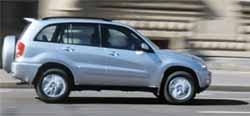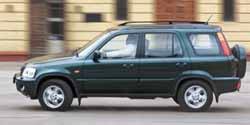Test Drive Honda CR-V 1996 - 2001 SUV
Little friends of real women
Several pages earlier you could get acquainted with the test of four very expensive (50-80 thousand dollars) of SUVs. Without waiting for the next issue of the magazine, we offer you another series on the same topic three Japanese, significantly less expensive, parquet all-terrain vessels.Among the Toyota Rav4, Honda CR-V and Suzuki Grand Vitara selected for testing (Toyota Rav4, Honda CR-V and Suzuki Grand Vitara). Toyota RAV4, rightly considered the ancestor of road all-terrain vehicles, is represented by the model of the newest, second generation. The world's most popular Honda CR-V in the Russian market for the second year in a row confidently keeps second in the number of cars sold among new imported SUVs. Suzuki Grand Vitara and abroad, and we have in demand as one of the least expensive jeeps (not counting Korean Kia Sportage and Russian Niva).
 Construction and layout
Construction and layout All three cars without claiming the status of full-fledged passing, in the design and in the layout have nothing to do with ordinary cars (with the exception of force aggregates). This means that their body and suspension, unlike, say, Subaru Forester are designed with a clean sheet and taking into account off-road operation. The most traditionally off-road connoisseur Suzuki Grand Vitara: frame body, a longitudinal engine connected when the front-wheel drive is necessary, the continuous rear axle. The rest use the carrying structure of the body, transverse power units and completely independent suspensions. The four-wheel drive is either constantly enabled (Toyota), or the automatically connected rear axle when the front wheels are slipped (Honda). For testing, we picked up the most popular five-door modifications with double-liter motors and automatic transmissions.
 Exterior appearance
Exterior appearance All three Japanese jeep produce a completely different appearance. Toyota stands out the most memorable and expressive appearance. The Rav4 appearance exactly corresponds to the assignment of the car. This is not an all-terrain vehicle for heavy work in the road, but transport for surfista, skier or a fan of mountain bikes. In accordance with this, off-road proportions, and sports motives were reflected in the design of the car. In the new RAV4, designers managed to embody difficultly compatible qualities: functionality, harmony and originality. In this regard, a new RAV4 decent relative of an impressive baby Toyota Yaris.
The design of Honda CR-V is based on another ideology. External restraint and conciseness. With the exception of the outdoor spout, Honda is deprived of any off-road attribute. CR-V gives the impression of a purely practical, modest, but elegant wagon that does not claim the role of playboo. And, as the good sales of this model shows, a purely all-place appearance is not important for all buyers of parquet passing.
 Perhaps, less than others we were pleased with the appearance of Suzuki Grand Vitara. An ordinary wagon is significantly lost by massive bottom strapping (bumpers bampers, wheels and door lining). It seems to us that the first generation of Suzuki Vitara was even more interesting.
Perhaps, less than others we were pleased with the appearance of Suzuki Grand Vitara. An ordinary wagon is significantly lost by massive bottom strapping (bumpers bampers, wheels and door lining). It seems to us that the first generation of Suzuki Vitara was even more interesting. If in the outdoor design of passenger cars, expressiveness and recognition are of great importance, then in the interior style for many, calm unobtrusion, which may not be remembered, but not annoying. This approach is characteristic of the design of interiors of very many Japanese cars, including for Honda CR-V and Suzuki Grand Vitara. The design of the front panels of these cars, distinguishing in the intensities and detail, leaves a very similar impression. Honda CR-V is a little bit down due to the horizontal insert from soft plastic lighter shade. It was pleasantly surprised and leather interior decoration. Suzuki uses only rigid plastics with the texture of the Soft-Look type, successfully imitating a soft surface.
In the interior decoration, the Toyota RAV4 also uses high-quality rigid fakes under soft plastics, but in general the design is bright, in the sporting spirit. The stylistics of the interior of the new RAV4 liked more than that of competitors, although it is impossible not to criticize silver but clearly not from the present aluminum overlays on the central console.
 Ergonomics, capacity
Ergonomics, capacity Turning away from the appearance to the ergonomics of the driver's workplace, immediately note that the main difference in the shape and rigidity of the seat. Rav4 These indicators are optimal for the seat conveniently covers the body and provides good lateral support. Suzuki is too soft, amorphous. CR-V is too convex lumbar seat backrest and insufficient side support. However, due to the adjustments of the seat (the most of all at the Honda CR-V) and the steering column (only by tilting), the search for convenient working postures in all three cars does not cause significant difficulties. Another obvious difference belongs to the location of the automatic box selector at Honda CR-V, he is an American on the steering column, Suzuki and Toyota in European seats. The European location seems to us more convenient, although in the absence of manual switching mode it does not matter. But the transfer of the lever on the steering wheel frees the passage between the seats, although the possibility of a walk through the cabin in a small car can hardly be considered an important advantage.
 The speciously most roomy car would have to be the Honda CR-V is the longest and base, and in size. The bigger surprise has become almost the same useful capacity of Toyota RAV4. The space for the feet of the rear passengers in both cars is worthy of large class E sedans, though, provided that the Toyota has a rear seat as much as possible back. Here it should be noted that, in addition to adjusting the tilt of the rear seat back, RAV4 has a very efficient longitudinal adjustment, moving the second row of seats back by as much as 150 mm. At the same time, the volume of the trunk decreases from 500 l to 400 liters, nevertheless remaining a little big than that of Honda CR-V. The fact is that RAV4 has more trunk depth, and the CR-V part of the trunk height occupies a folding table for picnics. It should be noted that the rear seats at RAV4 may not only be folded, but also to endure from the car. Suzuki Grand Vitara is inferior to both competitors and the length of the cabin, and by the volume of the trunk.
The speciously most roomy car would have to be the Honda CR-V is the longest and base, and in size. The bigger surprise has become almost the same useful capacity of Toyota RAV4. The space for the feet of the rear passengers in both cars is worthy of large class E sedans, though, provided that the Toyota has a rear seat as much as possible back. Here it should be noted that, in addition to adjusting the tilt of the rear seat back, RAV4 has a very efficient longitudinal adjustment, moving the second row of seats back by as much as 150 mm. At the same time, the volume of the trunk decreases from 500 l to 400 liters, nevertheless remaining a little big than that of Honda CR-V. The fact is that RAV4 has more trunk depth, and the CR-V part of the trunk height occupies a folding table for picnics. It should be noted that the rear seats at RAV4 may not only be folded, but also to endure from the car. Suzuki Grand Vitara is inferior to both competitors and the length of the cabin, and by the volume of the trunk. Dynamics of acceleration, handling, brakes
In the dynamics of overclocking among the participants of this test there are two leaders (Toyota and Honda) and one outsider (Suzuki). Actually, RAV4 could be the sole winner if not an increased thought of automatic transmission when switching to Kick Dawn mode. The Honda CR-V response to the pedal to the floor works faster and smoothly. Suzuki also sins the thoughtfulness of the machine, but it is exacerbated also and obviously less motor capabilities. Having arranged improvised competitions on the windows and an unloaded country highway, we made sure that Honda and Toyota can be kept on equal, and Suzuki lags behind. Of course, not only the possibilities of power units, but also characteristics of manageability affected.
 By the way, about the controllability of generalized alignment is the same as in the dynamics of overclocking, with the only difference that the backlog of Suzuki is even more. Honda and Toyota are characterized by good passenger behavior on a solid road. Moreover, Toyota is a little sporty slightly sharper reaction to the steering wheel (the sensitivity of the steering), slightly less the casual rolls in the turn. But at Honda CR-V, there is an advantage of a more intentional reactive action (informativeness) of the steering. Suzuki is perceived as a car belonging to the previous generation. Steering is less accurate, with sluggish sensitivity and bad informative. Fast movement by imperfect asphalt causes the need for constant infringement, and the car rearranges irregularities. Suzuki can still win in comparison with the VAZ classic, but not with modern counterparts.
By the way, about the controllability of generalized alignment is the same as in the dynamics of overclocking, with the only difference that the backlog of Suzuki is even more. Honda and Toyota are characterized by good passenger behavior on a solid road. Moreover, Toyota is a little sporty slightly sharper reaction to the steering wheel (the sensitivity of the steering), slightly less the casual rolls in the turn. But at Honda CR-V, there is an advantage of a more intentional reactive action (informativeness) of the steering. Suzuki is perceived as a car belonging to the previous generation. Steering is less accurate, with sluggish sensitivity and bad informative. Fast movement by imperfect asphalt causes the need for constant infringement, and the car rearranges irregularities. Suzuki can still win in comparison with the VAZ classic, but not with modern counterparts. It may be the only nomination of this test, in which it is difficult to highlight leaders and lagging, are brake properties. All rivals are equipped with ABS systems that have not caused any significant complaints.
With a uniform movement, all three cars are sufficiently silent, they do not particularly annoy the aerodynamic noise, nor the sound of rolling tires nor the voice of the motor. But with intensive acceleration, the picture changes dramatically. Toyota only slightly increases the softwear of its motor, while the Honda CR-V engines and Suzuki Grand Vitara express their protest, and Suzuki does it particularly sharply.
Compared to ordinary cars, all three parquet SUVs are distinguished by an increased energy intensity of the suspension, allowing them to rather painlessly swallow significant defects of our roads. At the same time, a sharp small thing is transmitted quite clearly. In general, on the smoothness of the course in front of Honda, with a little lag behind her Toyota and a little more from them behind Suzuki.
Patency
In the section Patency, Suzuki Grand Vitara got the opportunity to partially compensate for the loss in previous nominations of this test. The main advantage of Suzuki in the presence of a downstream, allowing in particularly difficult conditions to move in the tractor mode. In addition, Grand Vitara has the highest angle of entry and a rigidly connected front wheel drive.
The second on passability, thanks to the automatic locking of the central differential and the rear differential of increased friction, is Toyota RAV4. Yes, and in the geometric passability of RAV4 only a little inferior to Suzuki.
Toyota RAV4.
+
1. Expressive design
2. Handling
3. Dynamics of overclocking
4. Silence
-
1. High price
Honda CR-V
+
1. Handling
2. Dynamics of overclocking
3. Reasonable price
-
1. Regarding
weak SUVs
Suzuki Grand Vitara.
+
1. Low
price
2. Advantages
in Pentality
-
1. Disadvantages
controlness
Weaker than everyone in off-road looks Honda CR-V with the longest skes of the body, the lowest angles of entry-congress and without any locks. True, as we have seen a hydraulic coupling that connects the rear wheel drive, it triggements quickly after the start of the front slip, but the name of the slip itself in critical conditions can become an irresistible obstacle. Little remark: If you decide to experience the limits of passability of any of these cars, keep in mind that none of them, as they say, is not suitable at the notes.
RESULTS
When summing up this comparative test, it seems to be the obvious conclusion: Toyota RAV4 and Honda CR-V leads almost a nostril in a nostril under the obvious lag behind Suzuki Grand Vitara. Moreover, Toyota is still ahead of HOND, at least at the expense of freshness, novelty and greater external expressiveness. But all this is excluding an important factor of value. Five-door RAV4 with an automatic machine costs foolishly many 37 thousand dollars, CR-V from 27,900 thousand, and Grand Vitara is only 24 thousand. It turns out that selecting CR-V instead of RAV4, you can save on peugeot 206 for spouses, and the difference Between Toyota and Suzuki allows you to count on the purchase of Skoda Octavia. It remains to hope that the price of the RAV4 is established on the minimum and subsequently will be reduced, but now the most reasonable compromise is the purchase of Honda CR-V. As for Suzuki Grand Vitara, then such a price with quite acceptable quality is a big plus. As a moderately expensive alternative for the three heroes of our test, Land Rover Freelander and Subaru Forester can be offered. Freelander is highlighted by off-road external expressiveness, and Forester, especially with a turbocharged motor, the choice of the driver-enthusiast.
Roman Sergeev
Photo by Alexander Nosdrin
A source: Cars
Test drives Honda CR-V 1996 - 2001
Honda CR-V 1996 malfunction - 2001
Malfunctions Honda CR-V: Details| CR-V 1996 - 2001 | |
|---|---|
| Engine |  |
| Transmission |  |
| Management and suspension system |  |
| Brake system |  |
| Heated air and air conditioning |  |
| Start and Charging System |  |
| Electrical components and other |  |
| Body resistance to corrosion |








